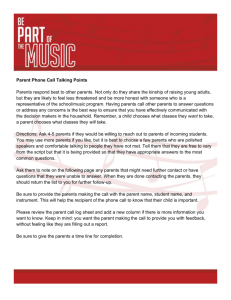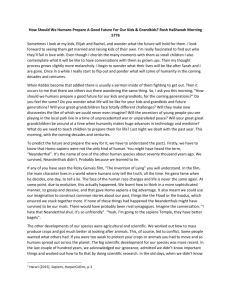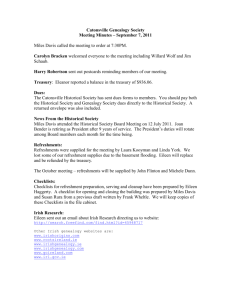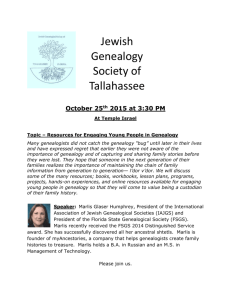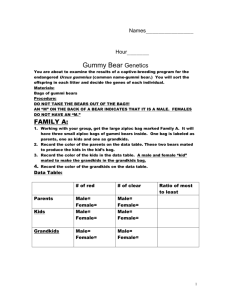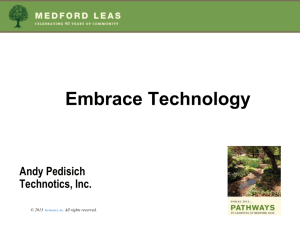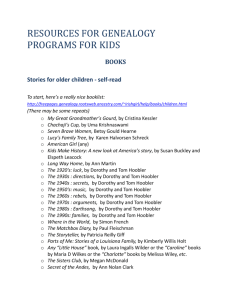Genealogy and Family History for the NEXT Generation Making it
advertisement
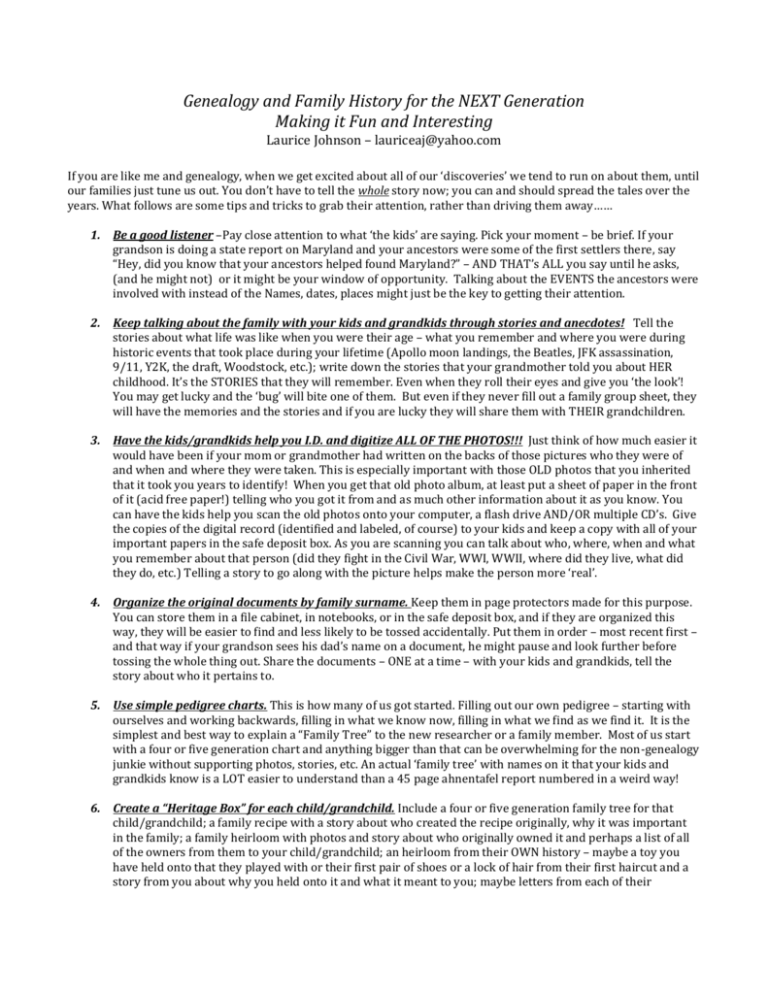
Genealogy and Family History for the NEXT Generation Making it Fun and Interesting Laurice Johnson – lauriceaj@yahoo.com If you are like me and genealogy, when we get excited about all of our ‘discoveries’ we tend to run on about them, until our families just tune us out. You don’t have to tell the whole story now; you can and should spread the tales over the years. What follows are some tips and tricks to grab their attention, rather than driving them away…… 1. Be a good listener –Pay close attention to what ‘the kids’ are saying. Pick your moment – be brief. If your grandson is doing a state report on Maryland and your ancestors were some of the first settlers there, say “Hey, did you know that your ancestors helped found Maryland?” – AND THAT’s ALL you say until he asks, (and he might not) or it might be your window of opportunity. Talking about the EVENTS the ancestors were involved with instead of the Names, dates, places might just be the key to getting their attention. 2. Keep talking about the family with your kids and grandkids through stories and anecdotes! Tell the stories about what life was like when you were their age – what you remember and where you were during historic events that took place during your lifetime (Apollo moon landings, the Beatles, JFK assassination, 9/11, Y2K, the draft, Woodstock, etc.); write down the stories that your grandmother told you about HER childhood. It’s the STORIES that they will remember. Even when they roll their eyes and give you ‘the look’! You may get lucky and the ‘bug’ will bite one of them. But even if they never fill out a family group sheet, they will have the memories and the stories and if you are lucky they will share them with THEIR grandchildren. 3. Have the kids/grandkids help you I.D. and digitize ALL OF THE PHOTOS!!! Just think of how much easier it would have been if your mom or grandmother had written on the backs of those pictures who they were of and when and where they were taken. This is especially important with those OLD photos that you inherited that it took you years to identify! When you get that old photo album, at least put a sheet of paper in the front of it (acid free paper!) telling who you got it from and as much other information about it as you know. You can have the kids help you scan the old photos onto your computer, a flash drive AND/OR multiple CD’s. Give the copies of the digital record (identified and labeled, of course) to your kids and keep a copy with all of your important papers in the safe deposit box. As you are scanning you can talk about who, where, when and what you remember about that person (did they fight in the Civil War, WWI, WWII, where did they live, what did they do, etc.) Telling a story to go along with the picture helps make the person more ‘real’. 4. Organize the original documents by family surname. Keep them in page protectors made for this purpose. You can store them in a file cabinet, in notebooks, or in the safe deposit box, and if they are organized this way, they will be easier to find and less likely to be tossed accidentally. Put them in order – most recent first – and that way if your grandson sees his dad’s name on a document, he might pause and look further before tossing the whole thing out. Share the documents – ONE at a time – with your kids and grandkids, tell the story about who it pertains to. 5. Use simple pedigree charts. This is how many of us got started. Filling out our own pedigree – starting with ourselves and working backwards, filling in what we know now, filling in what we find as we find it. It is the simplest and best way to explain a “Family Tree” to the new researcher or a family member. Most of us start with a four or five generation chart and anything bigger than that can be overwhelming for the non-genealogy junkie without supporting photos, stories, etc. An actual ‘family tree’ with names on it that your kids and grandkids know is a LOT easier to understand than a 45 page ahnentafel report numbered in a weird way! 6. Create a “Heritage Box” for each child/grandchild. Include a four or five generation family tree for that child/grandchild; a family recipe with a story about who created the recipe originally, why it was important in the family; a family heirloom with photos and story about who originally owned it and perhaps a list of all of the owners from them to your child/grandchild; an heirloom from their OWN history – maybe a toy you have held onto that they played with or their first pair of shoes or a lock of hair from their first haircut and a story from you about why you held onto it and what it meant to you; maybe letters from each of their grandparents or parents about their own life – if the recipient is a child maybe stories about the events and lifestyles when the same age (i.e., my parents told stories about growing up during the depression and WWII for their teenage/young adult grandchildren). 7. Create a Family History Scrapbook or Picture Book. This is NOT the scholarly, well-sourced, 25 generation family history that you are writing (although I am sure that it will be wonderful). What I am talking about is putting the PICTURES and the STORIES that go with them into an organized, perhaps chronological, format. Make the stories about the pictures, and keep them short, fun and don’t make them sound like the ‘begats’ chapters of the Bible! Include pictures of the heirlooms alongside of the information about the people that created or owned them originally. Include photos of the places/houses/schools/etc. associated with the ancestors. Include maps. Make the pictures and stories the focus. It doesn’t have to include the WHOLE family – you can make it just about one person and something that they did in their life. 8. Share the family history in bits and pieces. I have a friend who has a face-time chat every Sunday evening with her grand-daughters. Every week she tells them about ONE little fact or discovery she made about the family history. One week there was a lot of ‘stuff’ going on so she didn’t get around to the genealogy. She was just about to sign off when one of the girls said “Wait Grandma, what about the genealogy this week?” – it totally made her day and encouraged her that they were paying attention and that her efforts were appreciated and noticed. 9. Become VERY familiar with today’s technology! Instagram, facebook, google plus, youtube, pinterest, the wiki, face-time, ten zillion apps – this is where today’s generation lives. IF you want to truly connect with them and get them to connect with you, then you need to be familiar with their world. This is where I struggle and probably you do too, so ask one of your grandkids to help get you up and running – if they are like most kids today they are more than capable in using these computer/smartphone tools. There is a LOT of genealogy available in all of these platforms. Remember, when trying to interest the NEXT generation in the family history, your best bet is to drop BREADCRUMBS, not to serve a 12-course banquet – a little will go a long way.






